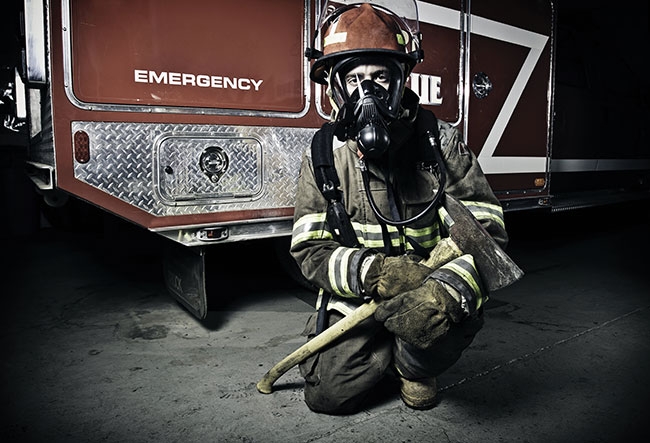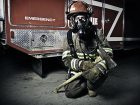
Features
Prevention
Reducing risk
Broken windows. Over-grown grass. Mail piled up on the doorstep. Canadian fire departments know that if they ignore these signs for long, fires and crime will eventually follow.
May 15, 2019
By Len Garis & Karin Mark
 The Surrey Fire Department is part of an initiative in the B.C. city to secure distressed properties to make them safer. Broken windows. Over-grown grass. Mail piled up on the doorstep.
The Surrey Fire Department is part of an initiative in the B.C. city to secure distressed properties to make them safer. Broken windows. Over-grown grass. Mail piled up on the doorstep.Distressed properties create costly safety and enforcement problems in communities across the country, while also contributing to long-term neighbourhood decline. Making the absentee owners take responsibility can be difficult and time-consuming – but one city in British Columbia has developed an approach that works.
The City of Surrey, a community of about 550,000 in Metro Vancouver, has to date secured more than 420 distressed properties, reduced related fires by up to two-thirds, and recouped more than $853,000 from property owners through its Distressed Properties Initiative.
Launched in January 2018, the program forces property owners to either secure their property or pay the city to do it for them. Cost-recovery is 100 per cent.
“The concept of owner responsibility is at the heart of the initiative,” said Surrey Deputy Fire Chief Mark Griffioen, who manages the program. “We’re leveraging tools that are available to all cities – such as provincial fire codes and the development of bylaws – to make sure taxpayers at large don’t pay the cost when owners ignore their responsibilities. And by doing so, we’re making our community safer for everyone.”
Surrey took action on distressed properties after seeing an increase in fires in abandoned homes, which also become targets for vandalism, drug use, squatting, drug production, prostitution and other illegal activities. In the years leading up to the program, abandoned homes were causing hundreds of visits each year by bylaw and fire personnel, and an average of two to three fires per month.
The city’s program was based on the 2016 study Distressed Properties: Pathways of Decline and the Emergence of Public Safety Risk from the University of the Fraser Valley (UFV) in B.C. by authors Len Garis, Larry Thomas and Alex Tyakoff.
Based on recommendations from the study, Surrey developed a method to identify properties heading towards a distressed state, and created bylaws to force owners to secure their properties (initially fencing, boarding and barriers, escalating to a security system).
The city also created a Community Property Safety Team (CPST) that follows established operational guidelines, addresses emerging issues and develops long-range strategies. The CPST includes a clerk and two full-time firefighters from the Electrical and Fire Safety Team. Tools to assist the team include a map of hotspots for abandoned homes and a mobile app with a property assessment checklist.
During 2018, the first full year of the program, the city identified 424 abandoned properties:
- 133 were secured at the cost of the owner;
- 203 were demolished at the cost of the owner;
- 52 properties were remediated and returned to the housing market; and
- The remaining 36 were still in the process of being addressed at the end of the year.
During that time period, property owners were charged $106,000 in city inspection fees, $55,000 in administration fees and $692,000 for the city to secure their properties.
At the same time, related fires dropped significantly. Thirteen fires took place in abandoned homes in 2018 – a 65-per-cent reduction from 2017 and a 130-per-cent reduction from 2016. There was also a declining trend over the course of the year, with only one fire in the last six months of 2018.
■ How it works
The CPST is alerted of possible abandoned homes by fire and city personnel as they go about their work, as well as by members of the public following a community outreach program.
The team has four stages of response:
- Identified properties receive a visual inspection from the street. Based on their current condition and history of fires, the properties are assigned to one of four categories – stable, vulnerable, stressed or distressed – for the appropriate action. Vulnerable properties are flagged for monitoring.
- Owners of stressed and distressed properties are sent a Notice of Inspection by registered mail. The property’s condition is then formally evaluated and, if necessary, an Order to Remedy Conditions is issued, including a date for compliance and a detailed package outlining the required security measures (such as boarding of windows, perimeter fencing and driveway barriers).
- A re-inspection of the property is conducted. If the owner did not comply, the city hires a contractor to install the security measures and bills the owner.
- Ongoing monthly re-inspections are conducted until the structure is demolished or renovated, or until further enforcement is required. If the site has been breached, the owner is required to install a security system with a security guard runner.
■ Next steps
The city continues to hone its process to enable a faster and more proactive response.
Presentations have been made to all other city departments to increase the number of “eyes” in the community. As well, based on a recommendation from the UFV study, a tool is being developed to help the city more accurately predict which properties are at risk of decline, rather than relying solely on public and staff reporting and monitoring.
The machine-learning model identifies at-risk properties by assessing data based on known predictors such as building age, property water consumption, and high land value but low building value.
Other indicators of property and neighbourhood decline include past crimes and bylaw violations, a history of unpaid property taxes or abandonment of properties, and neighbourhood demographic changes.
Preliminary results showed that up to 85 per cent of distressed homes may be identified through this proactive approach, compared to about 50 per cent through the reactive methods of reporting and monitoring.
Targeted monitoring of identified properties is now taking place to further test and fine-tune the model.
These enhancements will build on a successful program that has reduced the number of high-risk properties in Surrey, improved safety and helped to restore neighbourhoods, while ensuring that owners take responsibility for their properties.
“It’s been an exciting journey. In addition to reducing risks and recovering costs, we’ve been pleased to see so many former distressed properties return to the housing market,” Griffioen noted. “That’s the best possible solution for the community. It’s a win-win.”
The study can be downloaded for free from the UFV public safety and criminal justice research database at cjr.ufv.ca.
Interested departments may also contact Deputy Chief Griffioen at MEGriffioen@surrey.ca with questions.
Len Garis is fire chief for the City of Surrey, B.C., an Adjunct Professor in the School of Criminology and Criminal Justice & Associate to the Centre for Social Research at the University of the Fraser Valley, and a faculty member of the Institute of Canadian Urban Research Studies at Simon Fraser University. Contact him at Len.Garis@ufv.ca. Karin Mark is a former newspaper reporter who writes for publications and provides communications and design services in Metro Vancouver, B.C.
Print this page

